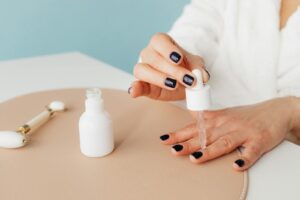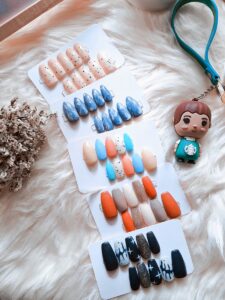7 Manicure and Pedicure Essentials for Safe Nail Health
Caring for your nails is about more than just looking good; it’s a vital part of your overall hygiene and health routine. Knowing the proper techniques and prioritizing cleanliness is what separates a great nail service from a risky one. That’s why understanding the core manicure and pedicure essentials is a must for anyone, whether you are a professional or just doing at-home maintenance. This guide breaks down the essential steps, focusing on safety, sanitation, and the proper techniques that lead to long-lasting nail health, minimizing the risk of infection or damage to your natural nail structure. We will cover everything from basic anatomy to the importance of trimming your toenails straight across.
1. The Foundation: Nail Anatomy and Health Checks
To care for your nails properly, you first need to know how they work. Understanding the basic nail health and structure is the first of the key manicure and pedicure essentials. Your nail is not just a hard plate; it’s a living system of different parts that require protection.
Understanding Your Nail Structure
The most visible part of your nail is the nail plate, which is composed of many layers of compacted protein called keratin. However, the true growth center is the nail matrix, located under the cuticle. Damage to the matrix—often caused by aggressive pushing or trauma—can permanently affect how the nail plate grows out, leading to ridges or uneven texture. The cuticle (technically called the eponychium) is the essential layer of skin that seals the space between the nail plate and the skin. It acts as a protective barrier, stopping water, germs, and bacteria from getting into the matrix, which could cause a serious infection.
Health First: When NOT to Perform a Service
A nail technician’s most important job is to recognize when a service should not be performed for health reasons. When you see signs of infection or disease, you must stop. For instance, **Onychomycosis** (a common fungal infection) causes the nail to thicken, crumble, or change color. Nail technicians cannot treat this; the client must see a medical professional. If a client has inflamed skin, severe redness, swelling, or any open cuts or sores near the nail, the service must be postponed. Ignoring these signs risks spreading infection. A common bacterial risk, **Green Nail Syndrome** (Pseudomonas bacteria), often happens when water gets trapped under a nail enhancement; it requires the enhancement’s removal and time for the nail to heal.
2. Mandatory Sanitation and Safety Essentials
The most crucial of all manicure and pedicure essentials is sanitation and safety. Unclean tools are the easiest way to transfer bacteria and fungi from one client to the next, causing serious cross-contamination.
The Three-Step Tool Sterilization Process
All reusable metal tools (nippers, pushers, metal files) must go through a careful three-step process between every client:
- Cleaning: The tool must first be scrubbed with soap and water to remove any visible debris, skin, or oils.
- Disinfection: Next, the cleaned tool is fully immersed in an EPA-registered solution (often called a hospital-grade disinfectant) for the amount of time specified by the solution’s label. This contact time is critical for killing germs.
- Storage: Once disinfected, the tool must be dried and stored in a closed, clean container to prevent it from getting dirty again before the next use.
Protecting the Client and Technician (Cross-Contamination)
Never reuse files, buffers, or toe separators between clients. These are single-use items and should be thrown away after one service. For items that cannot be immersed in liquid (like electric file bits), the technician must use an approved high-heat sterilizer or specialized cleaning methods. The high-risk area is the pedicure tub. Pedicure Bowl Safety is critical because the warm water environment is perfect for bacteria to multiply. The tub must be thoroughly cleaned, scrubbed, and disinfected with an EPA-registered solution after every single client, following strict procedures.
For more detailed information on tool requirements and approved solutions, consult the official guidelines from the Environmental Protection Agency (EPA).

Photo by Photo By: Kaboompics.com on Pexels
3. A Step-by-Step Guide to Basic Manicure Essentials
The classic manicure service follows a simple sequence designed to gently clean, shape, and condition the nail.
Preparation and Shaping
Start by removing any old nail polish. Use non-acetone remover for artificial nails to prevent damage, but acetone works best for natural nails and is required for gel removal. Next is shaping. To prevent cracking and splitting, always file the nail gently in one direction (from the side to the center), rather than sawing back and forth. The most common shapes are round, oval, or the slightly squared-off “squoval.”
Cuticle Care and Hydration
Proper cuticle care focuses on protection. Use a dedicated cuticle remover solution to soften the skin around the nail plate. Then, gently push back the cuticle (eponychium) using a soft wooden stick or a metal pusher wrapped in cotton. The goal is to lift the excess skin, not force it back aggressively. Only trim true hangnails or tiny pieces of dead skin; never cut the actual living cuticle, as this breaks the protective seal and can cause pain or infection. Finish the service with an exfoliation scrub and a relaxing hand and arm massage to promote circulation.
If you’re interested in learning how to perform these services professionally, explore our career paths in Nail Artistry: Nail Artistry Career Paths.
4. Pedicure Essentials: Focusing on Foot Health
Pedicures often involve more intense cleaning and are focused heavily on foot hygiene and comfort. The proper use of manicure and pedicure essentials for feet is key to preventing common foot problems.
The Soaking and Callus Management Phase
The service begins with soaking the feet in warm water. Soaking helps to relax the client and, more importantly, softens the skin and the nails for easier work. When dealing with thick, hardened skin, or calluses, it is vital to use safe callus removal methods. Use a foot file, pumice stone, or specialized buffer to gently reduce the hardness of the callus. A technician should never use a blade or sharp tool to cut a callus, as this can easily lead to injury, infection, and liability issues.
Proper Toenail Trimming for Ingrown Nail Prevention
The most critical step in a pedicure for long-term comfort is ingrown nail prevention. Toenails must always be trimmed straight across. Cutting the corners into a curve encourages the nail edges to grow into the soft skin of the toe, which causes painful ingrown nails. After trimming, you can lightly file the sharp corners just to smooth the edges.
The Perfect Polish Application
Applying polish correctly is the final essential step. To ensure the color lasts and the nail plate is protected, use the “sandwiched” approach:
- Base Coat: This thin layer protects the natural nail from staining by the color pigment and helps the polish stick better.
- Color: Apply two thin coats of color, allowing each coat to dry slightly.
- Top Coat: This thick layer seals the color, protects it from chips, and adds a lasting shine.
5. Beyond the Basics: Introduction to Advanced Services

Photo by Jenn Causing on Unsplash
As a technician, moving beyond the classic polish is part of expanding your manicure and pedicure essentials skill set.
Gel Polish: Strength and Longevity
Gel polish vs acrylic is a frequent question. Gel polish is essentially a liquid polymer that is painted onto the natural nail, just like traditional polish. The key difference is that it requires a UV or LED lamp to “cure” or harden instantly. This curing process makes the gel highly resistant to chipping, allowing the polish to last for up to two weeks or more. However, removal is non-negotiable: it must be done professionally by soaking the nail in acetone to avoid peeling and damaging the natural nail plate underneath.
Acrylic and Extensions
Acrylic is created by mixing a liquid monomer and a powder polymer to form a durable, strong layer. It is used to add significant length (extensions) or to add strength to very weak nails. Acrylic provides the greatest strength but is the most difficult to apply and remove, requiring long acetone soaks. Incorrect filing or aggressive removal of acrylic can severely damage the nail matrix and nail plate.
These services are often provided alongside other cosmetic procedures. Read more about related student services here: Basic Skincare and Facial Treatments.
6. Mastering Nail Care Consistency
The last of the manicure and pedicure essentials is consistency. Proper technique in the salon means nothing without good care at home. Regularly using cuticle oil keeps the protective seal (the eponychium) soft and flexible, helping to prevent hangnails and keeping the nail plate conditioned. Applying lotion daily, especially to the feet, prevents skin from cracking and developing deep calluses that become hard to manage. Regular maintenance services (every 2-4 weeks) keep the nails at a safe, functional length and ensure any minor issues are addressed before they become big problems.
7. The Role of the Professional
A trained professional provides the deep cleaning, safe exfoliation, and advanced techniques (like the correct use of electric files for enhancements) that cannot be safely done at home. Furthermore, a professional knows the signs of infection and disease and understands when to refer a client to a doctor. They are trained in meticulous sanitation and the correct use of professional-grade tools and disinfectants, offering a level of safety that is the ultimate essential for any service.
To learn more about identifying and managing fungal infections, consult reputable medical sources like the Mayo Clinic or the CDC.
Conclusion
Healthy, beautiful nails start with knowledge and end with safety. By prioritizing the core manicure and pedicure essentials—meticulous sanitation, correct anatomy knowledge, and gentle, intentional technique—you ensure the best possible results. Whether you are performing a service or receiving one, understanding the difference between proper cuticle care, safe callus removal, and the necessity of sterilization is the key to maintaining long-term nail health and overall comfort. Always seek out a trained professional who adheres to these strict standards.


